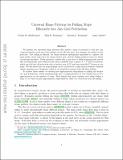| dc.contributor.author | Demaine, Erik D | |
| dc.contributor.author | Demaine, Martin L | |
| dc.date.accessioned | 2021-02-22T15:36:23Z | |
| dc.date.available | 2021-02-22T15:36:23Z | |
| dc.date.issued | 2020-08 | |
| dc.date.submitted | 2017-09 | |
| dc.identifier.issn | 0925-7721 | |
| dc.identifier.uri | https://hdl.handle.net/1721.1/129941 | |
| dc.description.abstract | We present two universal hinge patterns that enable a strip of material to fold into any connected surface made up of unit squares on the 3D cube grid—for example, the surface of any polycube. The folding is efficient: for target surfaces topologically equivalent to a sphere, the strip needs to have only twice the target surface area, and the folding stacks at most two layers of material anywhere. These geometric results offer a new way to build programmable matter that is substantially more efficient than what is possible with a square N×N sheet of material, which can fold into all polycubes only of surface area O(N) and may stack Θ(N2) layers at one point. We also show how our strip foldings can be executed by a rigid motion without collisions (albeit assuming zero thickness), which is not possible in general with 2D sheet folding. To achieve these results, we develop new approximation algorithms for milling the surface of a grid polyhedron, which simultaneously give a 2-approximation in tour length and an 8/3-approximation in the number of turns. Both length and turns consume area when folding a strip, so we build on past approximation algorithms for these two objectives from 2D milling. | en_US |
| dc.language.iso | en | |
| dc.publisher | Elsevier BV | en_US |
| dc.relation.isversionof | 10.1016/J.COMGEO.2020.101633 | en_US |
| dc.rights | Creative Commons Attribution-NonCommercial-NoDerivs License | en_US |
| dc.rights.uri | http://creativecommons.org/licenses/by-nc-nd/4.0/ | en_US |
| dc.source | arXiv | en_US |
| dc.title | Universal hinge patterns for folding strips efficiently into any grid polyhedron | en_US |
| dc.type | Article | en_US |
| dc.identifier.citation | Benbernou, Nadia M. et al. “Universal hinge patterns for folding strips efficiently into any grid polyhedron.” Computational Geometry: Theory and Applications, 89 (August 2020): 101633 © 2020 The Author(s) | en_US |
| dc.contributor.department | Massachusetts Institute of Technology. Department of Electrical Engineering and Computer Science | en_US |
| dc.relation.journal | Computational Geometry: Theory and Applications | en_US |
| dc.eprint.version | Author's final manuscript | en_US |
| dc.type.uri | http://purl.org/eprint/type/JournalArticle | en_US |
| eprint.status | http://purl.org/eprint/status/PeerReviewed | en_US |
| dc.date.updated | 2020-12-09T18:08:57Z | |
| dspace.orderedauthors | Benbernou, NM; Demaine, ED; Demaine, ML; Lubiw, A | en_US |
| dspace.date.submission | 2020-12-09T18:09:02Z | |
| mit.journal.volume | 89 | en_US |
| mit.license | PUBLISHER_CC | |
| mit.metadata.status | Complete | |
